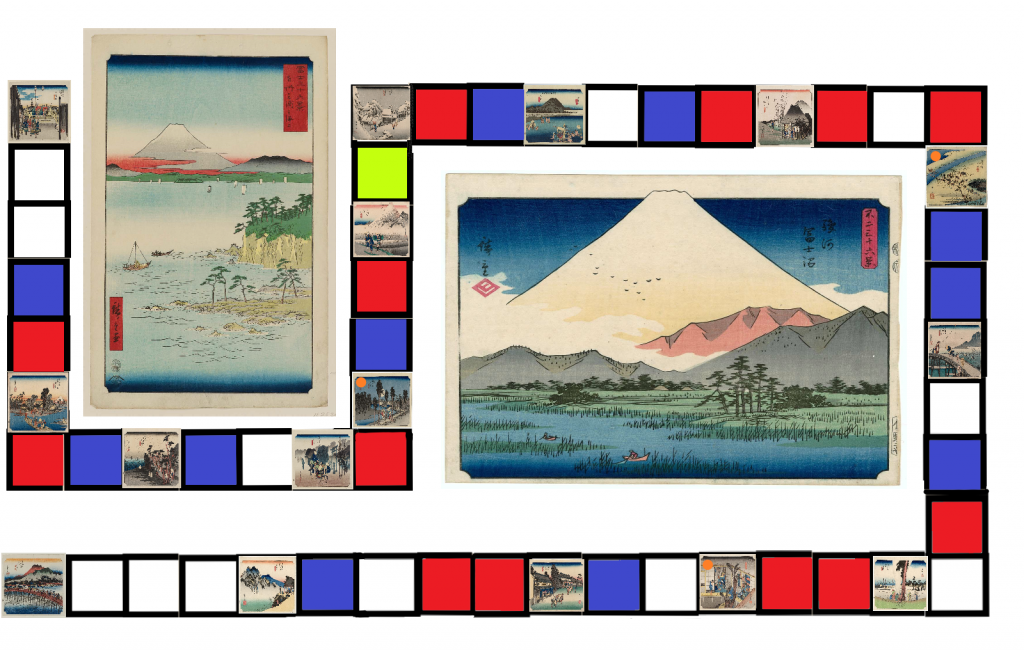by Lillian Liu
Play the game at the following link!
https://prezi.com/view/P2gKLKp3m6nVN7sySKWN/
Commentary
The Confessions of Lady Nijo is a legendary woman’s diary written in the Kamakura period. It was a hidden secret until Yamagishi Tokuhei found it by a wonderful stroke of luck in the Imperial Household Library in 1940 (Brazell, 1973). The story starts with the life of a captivating courtesan and slowly evolves into the lady’s transformation into an independent female traveller through her “Buddhist awakening” (Laffin, 2005). It equips readers with abundant information to perceive and analyze the life of a woman inside and outside the ancient Japanese imperial court.
Because travel is at the heart of this literary work, the sugoroku game serves as an innovative medium to take the players on a highly evocative and spiritual journey with the protagonist. Through travelling, Nijo seeks personal repentance as well as spiritual redemption for her father, herself, and her past lovers, including the Retired Emperor GoFukakusa, and the deceased monk Ariake. The game mirrors Nijo’s happiness and losses experienced in life. Each of the selected events are critical building blocks that led Nijo to the person she grew into. Only through these ordeals and trials did she become the writer of such awe-inspiring literature.
This game not only connects us to the protagonist of the story, but also creates bonds between players. The game juxtaposes key moments and themes in Nijo’s journey, including solitude and community, romantic love and independence, luxury and asceticism, joy and grief. When players land on certain woodblock paintings, they can
click the painting and the image will magnify. As the photo magnify, instructions for players are revealed. Players will not get penalized for landing on the less fortunate stops. Each stop serves a purpose and offers a time for freedom in interpretation. Each round will be unique and has its own cadence as players offer different opinions and interpretations. By having players move through different paintings and explore diverse questions posed by each step, I hope players can find resonances with and derive a newfound understanding of this classic literary work. The questions and instructions in the game are meant to be open-ended so that players could ponder and articulate unique responses with each other. This in turn helps the sugoroku game become a vibrant hub for literary analysis and for players to bond with each other over a video conferencing platform.
One of my motives for creating this game in the midst of a raging pandemic is to transport players to a different world that is both reminiscent of player’s travel experience as well as a world that is completely novel. I hope that players can feel energized and hopeful through participating in Nijo’s journey and this sugoroku game.
Instructions
Please search for a “Random Number Generator” in your browser. Set the lowest value
to 0 and the largest value to 3. Each player will take turn pressing the number generator.
Enjoy the game!
Works Cited
Brazell, K. (1973). The confession of lady Towazugatari. Stanford, CA: Stanford
University Press.
Laffin, C. (2005). Woman, Travel, and Cultural Production in Kamakura Japan: A Socio-
Literary Analysis of Izayoi Nikki and Towazugatari. Columbia University.
Image Citations
Bunkyo, Sakuragawa. (1788). An Entertainment at Shinagawa [Woodblock print]. The Metropolitan Museum of Art. https://www.metmuseum.org/art/collection/search/36706.
Hokusai, K. (ca. 1830–32). Tama River in Musashi Province (Bushū Tamagawa), from the series Thirty-six Views of Mount Fuji (Fugaku sanjūrokkei) [Woodblock print]. The Metropolitan Museum of Art. https://www.metmuseum.org/art/collection/search/56392.
Hiroshige, U. (1817–58). Boat on the Sumida [Woodblock print]. The Metropolitan Museum of Art. https://www.metmuseum.org/art/collection/search/460337.
Hiroshige, U. (1857). Sudden Shower over Shin-Ōhashi Bridge and Atake (Ōhashi Atake no yūdachi), from the series One Hundred Famous Views of Edo [Woodblock print]. The Metropolitan Museum of Art. https://www.metmuseum.org/art/collection/search/55433.
Hiroshige, U. (ca. 1840). Japanese White-eye and Titmouse on a Camellia Branch [Woodblock print]. The Metropolitan Museum of Art. https://www.metmuseum.org/art/collection/search/36722.
Hiroshige, U. (ca. 1834). Hiratsuka, Nawate Do [Woodblock print]. The Metropolitan Museum of Art. https://www.metmuseum.org/art/collection/search/55049.
Hokkei, T. (19th century). Woman in the Rain at Midnight Driving a Nail into a Tree to Invoke Evil on Her Unfaithful Lover [Woodblock print]. The Metropolitan Museum of Art. https://www.metmuseum.org/art/collection/search/54003.
Hiroshige, U. (ca. 1834). Yokkaichi, Sanchokawa [Woodblock print]. The Metropolitan Museum of Art. https://www.metmuseum.org/art/collection/search/36965.
